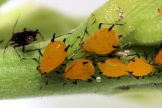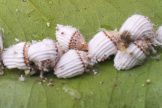
This disease has become almost endemic in apricot trees across Melbourne. It is now a disease that we need to prevent, live with, and manage. Gummosis is identified by the gum or sap that oozes from a wound in the bark of the tree. The wound can be from splitting during a rapid growth phase, physical damage from whipper snipper, mower or other accidental damage, or from boring type of insects.
When you first notice the oozing sap, look carefully to see if there is any frass or sawdust in the ooze. If there is, then you have a boring insect causing the damage. Insects tend to attack trees which are already stressed, so it helps to increase the vigour of your tree with a good watering and fertilising regime. Make sure it has good drainage and optimal pH.
Gummosis is a bacterial infection, so while spraying with a fungicide might make you feel proactive, but it is unlikely to solve your problem. The better approach is to start with good hygiene and clean up all fallen leaves and plant material on the ground. Trees are at their most susceptible as they are coming out of dormancy – do not prune over this time. You should always prune apricots in the warmer months (NOT in winter). This allows for a more rapid sealing of the pruning wound and reduces the opportunity for the bacteria to gain an access point to your tree. Only prune when the weather is dry. When pruning you should always disinfect your secateurs frequently during the process. A small spray bottle of methylated spirits will do the job. Make sure your secateurs are sharp to prevent any tearing and pulling.
Feed your apricot with a fertiliser high in potassium and phosphorus to encourage flowering and healthy growth. A good N:P:K ratio is 6:3:9. Fertilise in late winter, again in mid spring and lastly in mid summer if needed. Avoid feeding in late summer and autumn, as you do not want a lot of soft sappy new growth going into winter. This takes longer to harden off and is more susceptible to bacterial infection.
Promote good vigour in your tree by keeping the pH slightly alkaline. In this area (Manningham), the natural pH is neutral to slightly acidic, so an application of lime is a good idea. Fertilise regularly and water well, but ensure your tree is never sitting in water or is overly damp. Good drainage is important for apricots.
Apricots are prolific early bearers and a heavy load of fruit on young sappy branches can lead to splitting, especially in the branch crutches. You can thin the fruit, cut the branches shorter, prop up the branches or tie up the branches with broad soft ties. Splitting allows the bacteria an entry point – and is to be avoided whenever possible.
Gummosis will eventually shorten the life of your apricot tree, but in the meantime, you can live with it and still have a very productive tree for many years.





